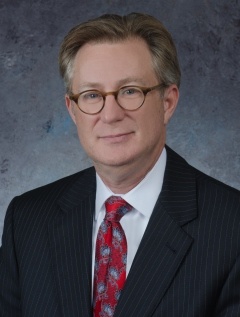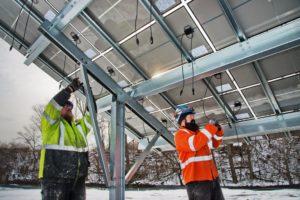This Guest Article for REVITALIZATION is written by Keith Burwell.
The history of Toledo, Ohio centers around Jeep vehicles and glass. Now, a project using glass solar panels to help revitalize the area around the former Toledo Jeep Assembly Plant is a dream come true, building a revitalized future on the past.
For more than six decades, the Jeep Plant hummed with activity. Surrounding neighborhoods thrived as home to its workforce and their families. When the Jeep Plant closed in 2006, it stood as the oldest operating assembly plant in North America, with a 64-year history of producing the iconic automobile.
The adjacent neighborhood had originally been established as the residential community for many of the plant’s workers. Following the decline and shuttering of the plant, which left a 110-acre brownfield in its place, the surrounding neighborhoods suffered from disinvestment, poor employment and educational opportunities, foreclosures, blight and crime. These neighborhoods currently have a population of nearly 6,000, of which 32% live below the poverty line.
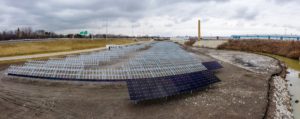 About ten years ago, the Toledo-Lucas County Port Authority (Port Authority) acquired the site and began the process of transforming the property.
About ten years ago, the Toledo-Lucas County Port Authority (Port Authority) acquired the site and began the process of transforming the property.
The effort to transform a 110-acre brownfield into a modern manufacturing complex included years of remediation and redevelopment totaling $16.8 million in state, local and private investments.
During this same time, Greater Toledo Community Foundation (GTCF) convened a Local Synergy Summit with a mix of partners to explore strategies to bring additional investment into the neighborhoods surrounding the planned site.
Through these efforts, participants identified resident engagement as a critical gap, and GTCF began investing in projects to build resident leadership and create a long-term strategy for community development.
In 2012, residents launched a neighborhood council committed to community revitalization, blight reduction and creative place-making. GTCF continues to assist residents in making connections to various institutions, intermediaries, and funding which has led to a number of beneficial projects including:
- An innovative job training program that partnered with Toledo Museum of Art and Center of Hope Family Services to prepare and connect nearby residents to the coming job opportunities in this area known as the Overland Industrial Park;
- A green infrastructure project supported by the Funders’ Network for Smart Growth and Livable Communities;
- Urban tree canopy restoration projects funded through the Great Lakes Restoration Initiative;
- A U.S. Environmental Protection Agency grant that engaged residents in development planning;
- The identification and demolition of 103 blighted structures through a partnership with the Lucas County Land Bank; and
- Multiple neighborhood beautification projects including two public art murals and a summer youth employment initiative.
From 2013 to 2017, GTCF invested and leveraged more than $500,000 to support the Overland Initiative. But uncovering a sustainable revenue model for community redevelopment remained a GTCF goal. In 2017, the long-term efforts of the Port Authority came to fruition when the first two manufacturing tenants moved into Overland Industrial Park – Dana, Inc. and Detroit Manufacturing Systems. Both produce automotive equipment.
That year, GTCF coordinated a series of meetings with leadership from multiple stakeholders including the Port Authority, First Solar (the largest solar panel manufacturer in the U.S.), Dana, Inc. (an auto parts supplier headquartered in the Toledo region and an industrial tenant at Overland Industrial Park) and GEM Energy (the electrical/solar installation arm of the Rudolph Libbe Group, a full service national contractor headquartered in Toledo).
These meetings resulted in the creation of the Overland Solar Initiative as a means to leverage business interests at the site to achieve community revitalization goals through the production and sale of renewable energy. The plan was that proceeds from these sales would provide a sustainable source of funding to support community and economic programs that benefit residents of the immediate area for years to come and create a new national model for sustainable community development funding.
To ensure the charitable mission of the Initiative was met, GTCF created a new Type 1 Supporting Organization at the Foundation to accept donations to the project and to own the solar array upon completion of construction. Dana, Inc. has committed to purchasing all of the energy produced by the arrays.
These proceeds will flow directly into the Supporting Organization. In addition to a Board of Directors, the Supporting Organization includes a Grants Advisory Committee that will make recommendations of how the funds will be invested in the local neighborhoods. This committee includes representation from the stakeholders donating to the project, as well as the neighborhood.
The Project
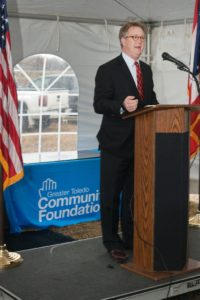
The author, Keith Burwell, president of Greater Toledo Community Foundation, officially kicks off the Toledo Overland Project at a ceremonial groundbreaking in November, 2019.
Now referred to as the Overland Solar Initiative, this developing project represents hope and rebirth for this critical region of the city. Over $2 million in cash and equipment (including glass panels) have been donated to construct a nearly three megawatt solar array to compliment newly opened, light manufacturing plants (including a Dana plant) at the former Jeep site.
The solar array will be owned by GTCF. Dana has agreed to purchase the electricity produced by the solar array to run its Driveline plant, and this revenue will be invested in the area for workforce development, educational programs and blight reduction.
One of the most innovative and collaborative projects in the history of northwest Ohio is underway, poised to produce renewable energy with the goal of supporting neighborhood reinvestment and creating resources to meet community needs. This project will provide funding for workforce development, job training, neighborhood improvements and more. And it all begins with the power of the sun.
The solar array, powered by First Solar’s American-made thin film module technology, will provide clean, renewable energy that Dana will purchase for its 300,000-square-foot Toledo Driveline facility, which is located in the park.
In turn, GTCF has created a nonprofit entity to own the solar field in conjunction with the Port Authority. By selling the electricity to Dana, the nonprofit’s revenue stream will be reinvested through grants to local nonprofits working to improve the surrounding neighborhood. Hundreds of thousands of dollars will be invested into the neighboring Overland communities.
The array is expected to generate power for at least 25 years, allowing the Overland Solar Initiative to adapt its focus to changing needs in the community and support long-term solutions with a consistent funding stream. The project has the potential to serve as a model for redevelopment finance in other parts of the country.
This type of collaboration among businesses, government and agency partners to deliver a sustainable community investment is unprecedented. The partners’ commitment to build a world-class solar-power generation site will provide funds that will be reinvested in the surrounding neighborhoods far into the future.
James Kamsickas, president and CEO of Dana said the project is much more than a solar project. “This unique collaboration allows Dana to capitalize on all the benefits of renewable energy while also making a significant economic impact on the residential neighborhoods surrounding our facility,” he explained.
The highly collaborative project includes support from the Toledo-Lucas County Port Authority which owns the land at the Overland Industrial Park and leases to the Foundation for $1 per year; First Solar, which donated the solar modules; Yaskawa Solectria Solar, which donated newly-designed inverters; and engineering and construction services from GEM Energy, JDRM Engineering, Kokosing Construction, the Mannik Smith Group and TTL Associates.
About Our Partners
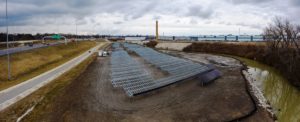 Module installation, started in late 2019, is scheduled to occur throughout 2020. GEM Energy has been contracted by GTCF to oversee the design and installation of the array, and is donating all of the project management, supervision and development time required. GEM’s project design calls for two separate arrays at the site covering nearly 20 acres of property.
Module installation, started in late 2019, is scheduled to occur throughout 2020. GEM Energy has been contracted by GTCF to oversee the design and installation of the array, and is donating all of the project management, supervision and development time required. GEM’s project design calls for two separate arrays at the site covering nearly 20 acres of property.
Kokosing, a construction company working on highway improvement projects that had been utilizing the project site for storage purposes, has graded the property to the specifications required by GEM. This work was an in-kind donation to the project. In addition, civil design and electrical engineering design work is being completed by local firms Mannik/Smith Group and JDRM Engineering respectively, as a contribution to the project. The grounds, in addition to the facility utilized by Dana, are owned by the Port Authority.
In 2019, First Solar approved the donation of solar modules to complete the project. This will serve as a showcase for the company’s product. These panels are produced at the company’s northwest Ohio manufacturing plant. The product donation is valued as high as nearly $1 million. Additionally, Yaskawa Solectria Solar approved a donation of their new inverters for the project. Solectria’s in-kind donation is valued at more than $200,000.
The project site for this installation is located in a highly trafficked area immediately adjacent to Interstate 75, north of Toledo. Contributors to the project will be prominently recognized on signage visible to commuters utilizing the highway. This signage will indicate the project partners, as well as details on the energy produced and charitable investments made to the community.
Sustainability of the Project
Once constructed, the Overland solar array will produce energy for an estimated 25 years. Dana has contracted to purchase the electricity for use in its Driveline plant, ensuring a steady source of income from the project.
Maintenance expenses related to the array will be covered by the Supporting Organization through funds generated by the sale of power. One benefit to solar power is the minimal maintenance required, meaning a greater percentage of funds can be distributed to support the community.
Impact at a Glance
- The Overland Solar Project will invest in a geographic area that has struggled since the former Jeep Plant’s closing. More than 32% of the residents now live below the poverty level;
- The solar array is expected to generate more than $320,000 in year one;
- The array will generate enough power to reduce carbon dioxide by more than 3,000 tons—which is equivalent to removing 465 cars from the roadways each year;
- Since the solar panels were donated and have an average lifespan of 25 years, this equals a potential $8,000,000 infusion for the surrounding neighborhoods; and
- Mark and Rose Makulinski, Greater Toledo Community Foundation fundholders and an incredibly philanthropic local couple, offered a Challenge Match of up to $500,000 for the Overland Solar Initiative, instantly doubling any project contributions.
You Can Support the Overland Solar Project
Greater Toledo Community Foundation thanks the many businesses who have donated over $2 million in materials and labor for the Overland Solar Initiative. Even with the significant contributions that have already been made to the project, funding needs still exist, particularly for labor on the project. GTCF is seeking partners to assist in providing support to realize this innovative project.
If you or your business would like to be part of this collaborative initiative, please contact me at the Foundation, (419) 241-5049 or Keith@toledocf.org.
Aerial photos are courtesy of GEM, Inc.
About the Author:
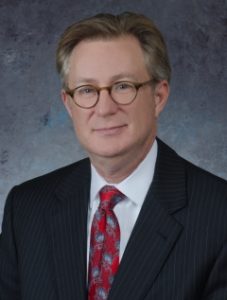 Keith Burwell is president of Greater Toledo Community Foundation, a position he has held since February 2004. He currently oversees an annual grants program averaging $17 million in grants and an annual asset development program averaging $19 million in new assets.
Keith Burwell is president of Greater Toledo Community Foundation, a position he has held since February 2004. He currently oversees an annual grants program averaging $17 million in grants and an annual asset development program averaging $19 million in new assets.
He currently serves on the Boards of the Imagination Station, Regional Growth Partnership, The Rotary Club of Toledo and Philanthropy Ohio; is a member of the Chronicle of Philanthropy Advisory Committee; Chair of the Ohio Community Foundation CEO Committee; and was appointed a member of The Federal Reserve Bank of Cleveland’s inaugural Community Advisory Council, as well as other local and national committees and boards. Keith continues to speak locally and nationally regarding issues affecting local philanthropy.
He graduated from Campbell University in Buies Creek, North Carolina. Keith received a master’s degree from Southwestern Baptist Theological Seminary in Fort Worth, Texas. He is married to Susan Burwell. They have two adult children: a son, Blake, and a daughter, Candace, and one grandchild.

